As far as we know, the life expectancy of C. elegans nematodes achieved in adults with drugs was the highest in our work. We used drugs that were originally intended for the treatment of various diseases of adults. The development of a method based on the use of already approved drugs acting simultaneously on several signaling pathways associated with aging is considered very promising. It can lead to preventing the development of age-related diseases and physical asthenia of the elderly population of the world, which is rapidly aging.
Introduction
One of the most important stages in the science of aging has been the discovery of evolutionarily conservative signaling pathways responsible for regulating the life span of an organism. Mutations in genes affecting these signaling pathways can lead to an extension of life expectancy from 30 to 100% in model organisms. Combined gene mutations can cause a synergistic effect that increases the life span. The effect of pharmacological interventions is usually much weaker than that of genetic mutations, even if they act on the same signaling pathways.
The presence of a synergistic effect with several combined gene disorders suggests that the use of such drugs that will simultaneously affect several evolutionary conservative signaling pathways will become a possible promising direction. To date, little data has been recorded on the synergistic effect of the use of drugs aimed at increasing life expectancy. In this paper, we report on the results of a new study performed in vivo in which such drugs were used. We have demonstrated how a combination of drugs can maximize the effect of therapy due to the fact that they act on several signaling pathways, with mutually reinforcing effect of each other. At the same time, it was possible to minimize the frequency of adverse reactions and the ¬ level of compensatory disturbances in the development of the body, since point changes were made in separate, but interacting, signaling pathways. The ultimate goal of the study was to develop a pharmacological treatment regimen for the adult population, with an effect proven on the aging process, which was equal to or greater than the effect of mutations.
Since there are few generally recognized biological markers of aging, currently, in order to evaluate the results of the study, they simply compare the total lifespan of organisms. A nematode of the species Caenorhabditis elegans was used as a short-lived model organism. Next, we selected several combinations of drugs, so that 2 groups of drugs were created, in each of which there were three drugs. As previously published in studies, when using these combinations of drugs, there was a significant difference in increasing life expectancy and prolonging the healthy life of C. elegans nematodes.
The synergistic effect obtained with the combination of drugs turned out to be comparable to that observed after directed mutations in the well-known genes associated with aging. We did not reveal any compensatory disturbances in the development of organisms from those that are often found and associated with pharmacological intervention. We were able to indirectly determine that drug therapy slowed down the rate of natural aging, as the level of some markers increased. In addition, we concluded that TGFβ (Transforming Growth Factor β1) was a key factor providing the synergistic effect of the signaling pathway. In addition, the study showed that in nematodes treated with the above combinations of drugs, the ratio of monounsaturated lipids to polyunsaturated ones changed the side of prevalence of the former (increase in the ratio of MUFA to PUFA), and the level of peroxidation of membrane lipids decreased. Finally, we confirmed that a similar synergistic effect was also determined in fruit flies of the species Drosophila melanogaster.
results
Choice of signaling pathways and targets in C. Elegans.
Based on modern scientific literature, we have found several evolutionary-conservative signaling pathways and mechanisms associated with aging (Supporting Material, Table S1). Among the targets and mechanisms that we selected were: AMP-activated protein kinase, c-Jun-N-terminal kinase (JNK), mammalian rapamycin target (mTOR) and mechanisms involved in the processes: calorie restriction (CR), mitogomesis (the effect of low doses of substances which in large doses are toxic) and mitochondrial metabolism. The above targets and processes are considered to be the main ones in the regulation of signaling pathways that prolong life. For each signaling pathway, drugs were determined whose effect on longevity was described in at least one of the known model organisms (nematodes, fruit flies or mice).
People tested drugs were of particular interest to us. Therefore, we have preferred drug compounds with declared efficacy in mammals or approved in humans. Initially, we found 11 potential drugs that met the above criteria (Auxiliary table S1). We added allantoin to our list based on a report on its ability to prolong life in C. elegans and the results of transcriptional analysis. We have suspicions that its mechanism of action is different from other substances. To avoid errors in measuring the life expectancy of organisms after the use of drugs, we first tested the contractor using the blind method. The main reason for this was the fact that the results of the study can greatly depend on the correctness of the experimental conditions and vary significantly among different laboratories. We used only those doses of drugs that were previously described in scientific papers. The effectiveness of five drugs that affect life expectancy has been repeatedly confirmed in our laboratory (Fig. 1, supporting table S2). As a rule, in our study, the effectiveness of compounds associated with an increase in the life of organisms was slightly lower than in previously published works (Supplementary Scheme 1, supporting table S2).
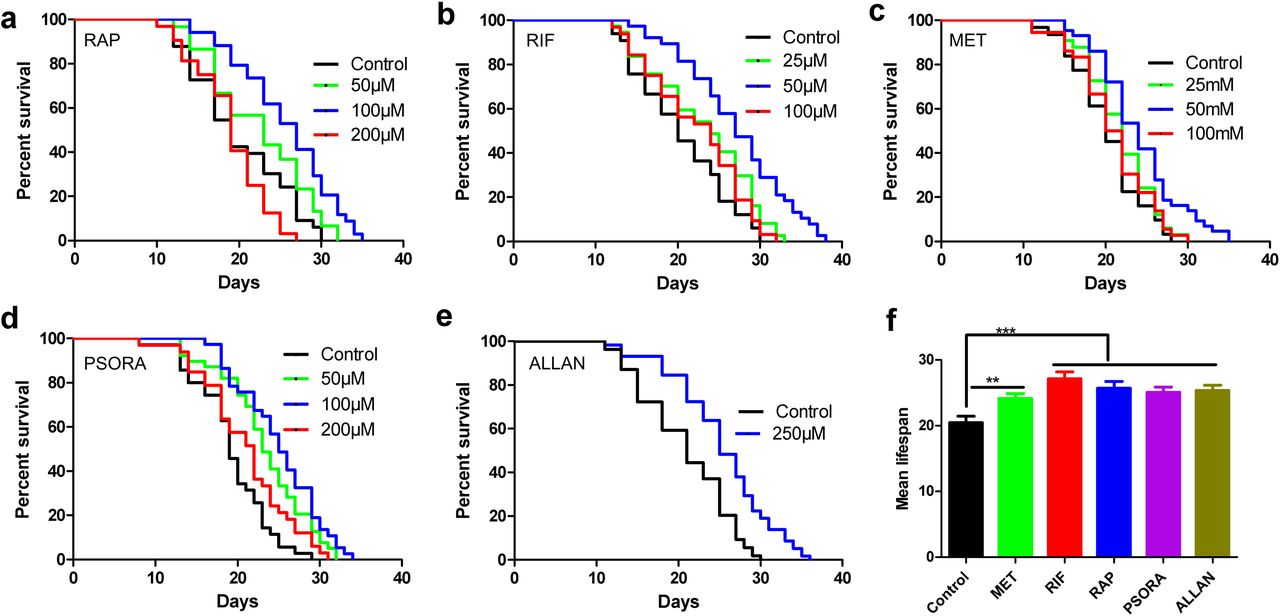
Fig. one
Transcript, drugs and longevity
To evaluate the effectiveness of the drugs in the study, we performed a transcriptome analysis and determined differentially expressed genes (DEG) and enriched the signaling pathways with respect to the control. We noticed certain differences in gene expression and signaling pathway activity in the experimental group, which were not in the control group. The most significant changes in gene expression and signaling pathways were caused by the action of one drug combination consisting of rifampicin, rapamycin and psora-4 (PSORA), where the last drug was administered after the first two. Unlike the drugs mentioned, metformin (MET) and allantoin (ALLAN) affected the expression of fewer genes (Scheme 2a, supporting table S3).
Analysis of the transcriptional results showed that each drug substance had its own unique profile of the genes altered by it. At the same time, some of these genes were also found in the transcriptional profiles of the remaining drugs (Scheme 2a). Thus, MET acted on the work of many “popular” genes, but the number of unique genes involved was minimal. MET and PSORA preparations changed the activity of almost the entire spectrum of “popular” genes, some of which were also individually affected by the drugs shown in Scheme 2a.
The ALLAN compound affected the smallest number of genes, but most of them belonged to a unique group. Less than half of its genes were represented in the transcriptional spectrum of other drugs. The effect of using RIF and RAP was significantly different from each other and from any other drugs. Based on the three criteria of the principal component analysis (PCA) method, we concluded that RIF, RAP, and PSORA were very separate from the rest of the drugs. In contrast, the effects of ALLAN and MET were more variable, but very similar. In addition, their results were somewhat close to the results of the control group.
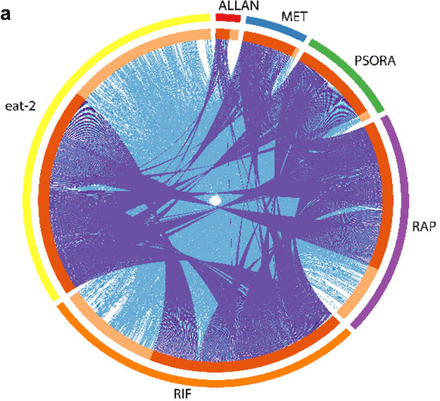
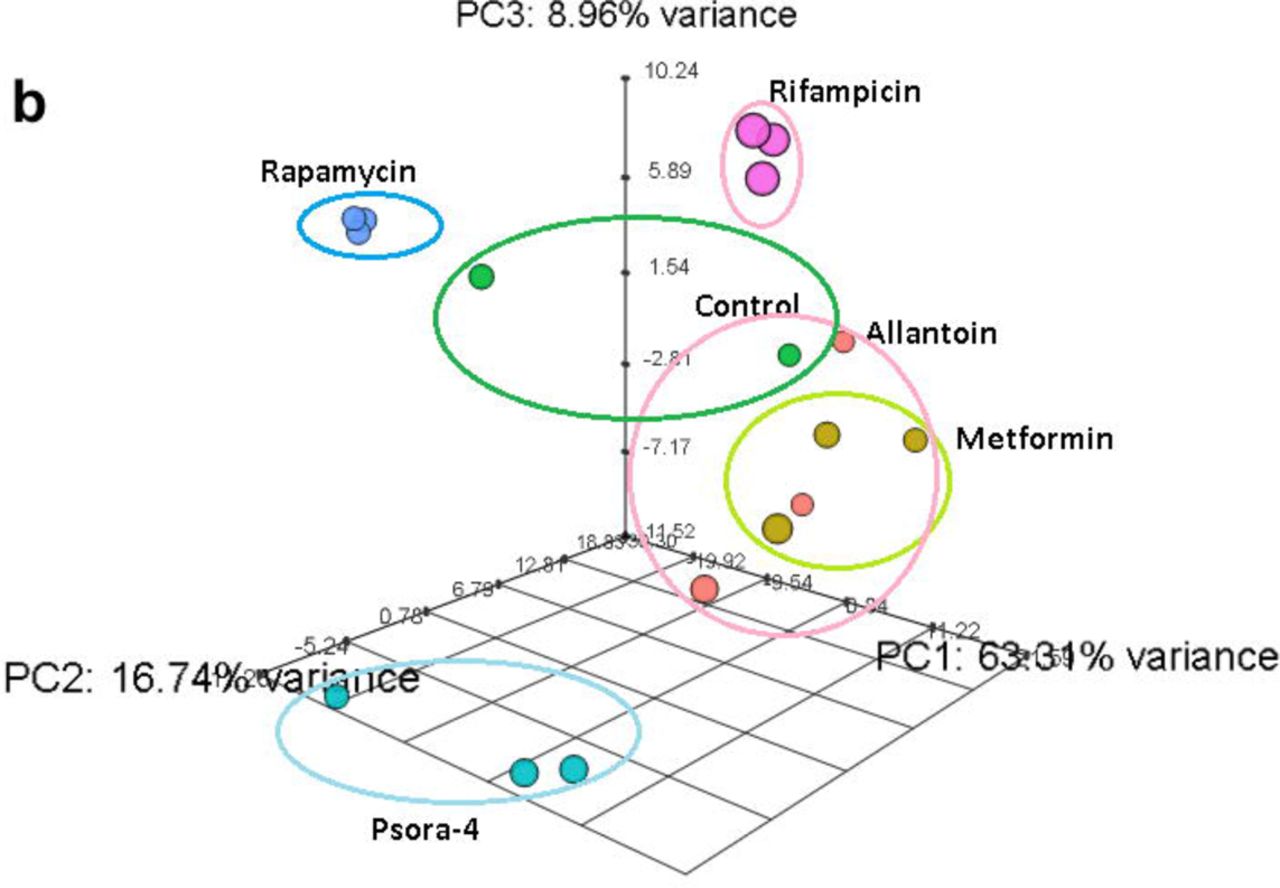


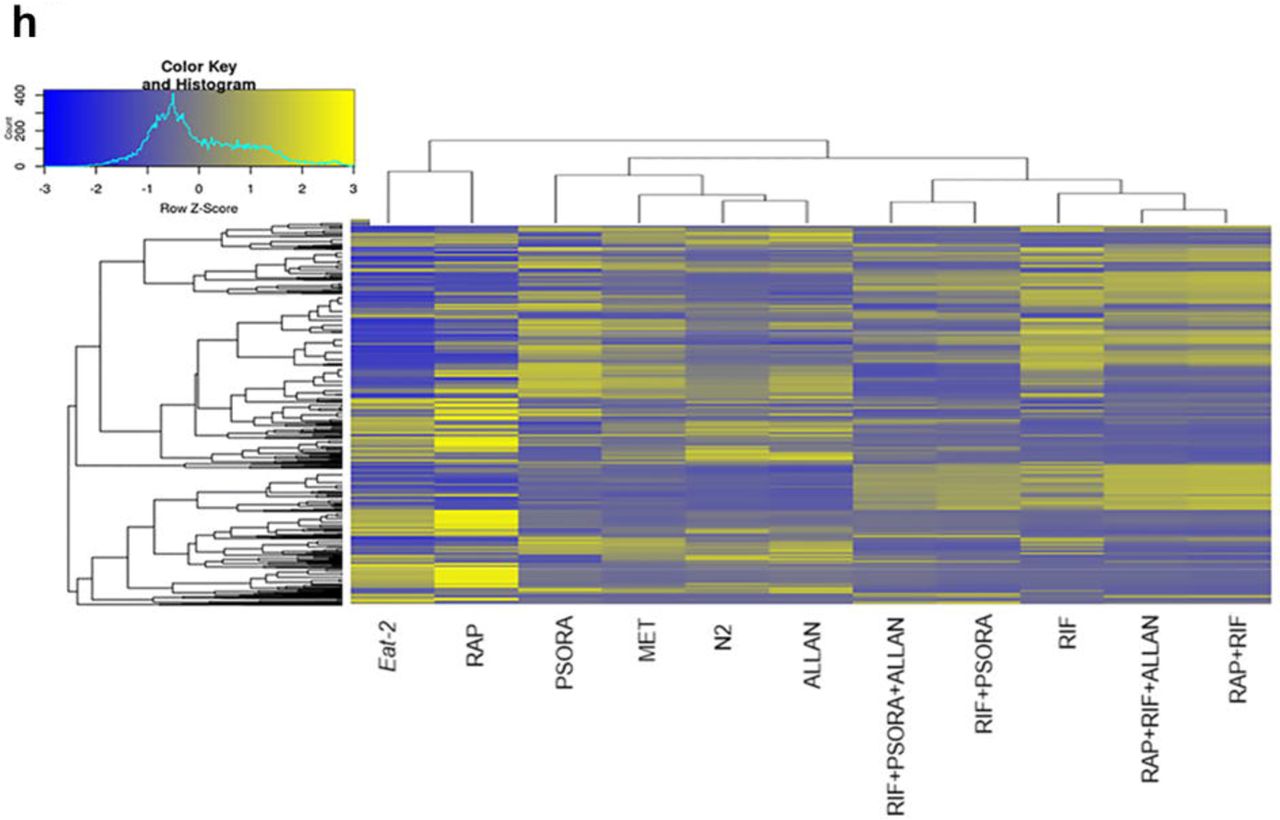
Fig.2
In the next step, we determined how various drug combinations affect the life time of nematodes. Since the actions of MET and RAP are easier to transfer to humans, we studied these drugs in the first place. However, it turned out that the combination of MET and RAP at optimal doses of 50 mg and 100 mg did not lead to an even longer lengthening of life (Supplementary Scheme 2 J, P). We performed several more studies using all possible combinations of these drugs in optimal and semi-optimal doses (Additional Scheme 2 JP).
The result of the use of MET and RAP in their semi-optimal doses was an increase in the maximum nematode lifetime (Scheme 2e, Additional scheme 2 m, s), but not the average life expectancy (Additional scheme, 2p). This slight advantage of MET and RAP is consistent with the findings of another study in mice. It proved that the addition of MET to the RAP mainly prolonged the life of the males, while the result in the females was hardly noticeable (when it was recorded at all).
Next, we sequentially found out the effects of 10 drug combinations. In each combination of drugs, there were two of the five possible drugs (Supplementary Scheme 2 ai). The analysis of the synergistic effect was carried out using the HSA-model (Higher Single Activity model), which estimates the degree of activity of one of the two drugs.
The result from the combined use of various drugs was considered synergistic, provided that it greatly exceeded the result obtained from the action of each drug separately and when the doses of the drugs were the same. Given the above definition, we found that only two out of ten combinations of drugs had a synergistic effect (Scheme 2c, d, Supplementary Scheme 2 and Supporting Table S2), fixed with a combination of drugs: RIF with RAP and RIF with PSORA. Three different drug combinations could be made with these drugs, but only two of them were most different from each other according to PCA analysis. It was in the last two that a synergistic effect was revealed (Scheme 2b, additional scheme 4a, b).
Among the remaining 8 pairs of drugs, the effect on life expectancy in 4 was the same as in the most effective drug in the corresponding drug combination. In 4 other combinations, the effect of one drug mutually excluded the effect of another. In the latter case, the absence of toxic reactions and an increase in the life span were also noted (Supplementary Scheme 2, supporting table S2).
In our study, the use of two combinations of drugs with a synergistic effect led to a more significant lengthening of life, compared with data published previously in the scientific literature. However, the increase in life expectancy after drug use was less than a similar effect from mutational disorders. In this regard, we have questions: are the true survival rates the maximum that can be achieved with drug treatment of adult animals? Will we get an additional increase in the lifespan by adding other compounds? If the combination of drugs will include three drug compounds, then the number of possible combinations will increase to 30. We did not have the opportunity to check such a number of drug combinations.
Therefore, we selectively studied the effect of some triple drug combinations. First of all, we considered a combination of drugs in which all three drug compounds were most different from each other based on the criteria of the PCA method. Another condition was the presence of a synergistic effect of the drug when used in conjunction with other drugs (RAP, RIF and PSORA). However, the nematode life expectancy when using a combination of the three drugs was worse than when using any double drug combination (Supplementary Scheme 3a, supporting table S2). Then we tested the effectiveness of the triple combination of drugs, which included the ALLAN drug with a unique profile of the genes involved (light orange arc, scheme 2a).
The activity profile of ALLAN genes did not match the profile of the active genes of other drugs. It also differed from the spectrum of the eat-2 mutant transcript. Thus, we hypothesized that the ALLAN compound has a unique mechanism of action and, therefore, added it to those two pairs of combinations that showed a synergistic effect. In both cases, a statistically significant increase in average life expectancy and its maximum was observed (Scheme 2f, g, additional scheme 3d-f and auxiliary table s2). The best result was the combination of three drugs: RAP, RIF and ALLAN, due to which the average life time of the worms doubled, and the median and maximum reached 44 and 50 days, respectively (Auxiliary table s2). The resulting effect was comparable to the effect of mutational disorders. According to our information, this extension of the life span of C. elegans was the largest that has ever been published in the scientific literature when using drugs used in adults.
The mechanism of drug synergy
Daf-16 / FOXO is a transcription factor that plays a key role in regulating the lifespan of model organisms, and probably also humans. In order to study the mechanism of synergistic action of the combinations of drugs that we identified, we determined their effectiveness when the worms had a mutation that was negative in Daf-16 signaling pathway. The effect of drugs such as RAP or ALLAN, taken separately, was independent of the Daf-16 signaling pathway. In comparison, the extension of life expectancy using RIF was completely due to the work of the Daf-16 pathway, and PSORA partially (Scheme 3a, additional scheme 8).
The synergistic combination of RAP + RIF drugs included one RIF drug, the effect of which was entirely dependent on the Daf-16 pathway, and another RAP drug with an effect independent of this signaling pathway. With the combined use of RIF + PSORA preparations, a synergistic effect was also recorded, despite the fact that the activity of the drugs was associated with the functioning of the Daf-16 pathway, and the nematode had a mutant Daf-16 gene (Scheme 3a, additional Scheme 8).
Such results were unexpected, because it turned out that the synergistic effect was caused not only by the Daf-16 pathway: this effect was achieved in mutants of the Daf-16 gene worms using drugs whose actions completely or partially depended on the functioning of this gene.

Fig.3
According to various authors, several of the drugs we tested were CR mimetics (Caloric restriction) i.e. medicinal substances, similar to naturally synthesized compounds in the body, responsible for a decrease in appetite. We used the eat-2 mutant C. elegans models to find out whether drug combinations and their drugs, which are characterized by synergistic action, affect CR signaling pathways. Only the RIF compound prolonged the life of eat-2 mutant nematodes. Therefore, all others except RIF preparations belonged to CR mimetics.
Thus, in two drug combinations, RAP + RIF and RIF + PSORA, one compound belonged to CR mimetics, and the effect of the other did not depend on the eat-2 mutation. The combined use of RIF and PSORA led to an increase in the lifespan of nematodes, while the addition of ALLAN to this combination of drugs had no effect on the increase in the lifetime of the worms. We believe that this pattern is due to the fact that in this combination of drugs ALLAN was the second CR mimetic.
In order to further study the mechanism of drug synergy, we made a transcriptome profile of drug combinations with a revealed synergistic effect and a drug combination without such an effect. Nematodes were given one, two or three drug compounds to detect the presence or absence of this effect. The transcript of individual drugs assigned to CR mimetics was clustered in the same region as the transcriptome profile of eat-2 mutant organisms. In contrast, the RIF compound did not have CR - mimetic activity and its transcript was different from the results of the transcriptional analysis of eat-2 mutants and other drugs (Scheme 2h).
It is interesting to note that the transcriptomes of drug combinations with a synergistic effect clustered together and the patterns of their gene expressions differed both from the expressions of individual drugs included in the combination and from eat-2 mutants (Scheme 2h, additional scheme 4 c, d). Compared with the control group, when using double and triple synergistic combinations of drugs, the TFGβ signaling pathway was often presented (Scheme 4a, additional scheme 6c, 7a, auxiliary table s4). In addition, we compared with a transcript the combination of drugs with a transcript of the drug compounds included in it, the latter in this case served as a control group (see methods). Unlike the control group, combinations of drugs with a synergistic effect enhanced the activity of TGFβ and several other signaling pathways. In drug combinations without synergistic effects, such pathways were not represented in the transcriptional profile (Auxiliary table s5).
Some combinations of drugs prolonged the life of eat-2 to mutant nematodes, but there are no individual drugs in these combinations. We decided to check whether the eat-2 mutants will have increased TGFβ pathway activity after synergistic combinations, in contrast to eat-2 worms without drug therapy. The only signaling pathway that was noticeably present in the transcript after using any of the synergistic combinations of drugs was the TGFβ pathway (Additional Scheme 7b, supporting table S6). It was a complete surprise for us that this path was exclusively determined by the action of synergistic combinations of drug compounds (Scheme 4b, additional scheme 7a, c, auxiliary table s7).
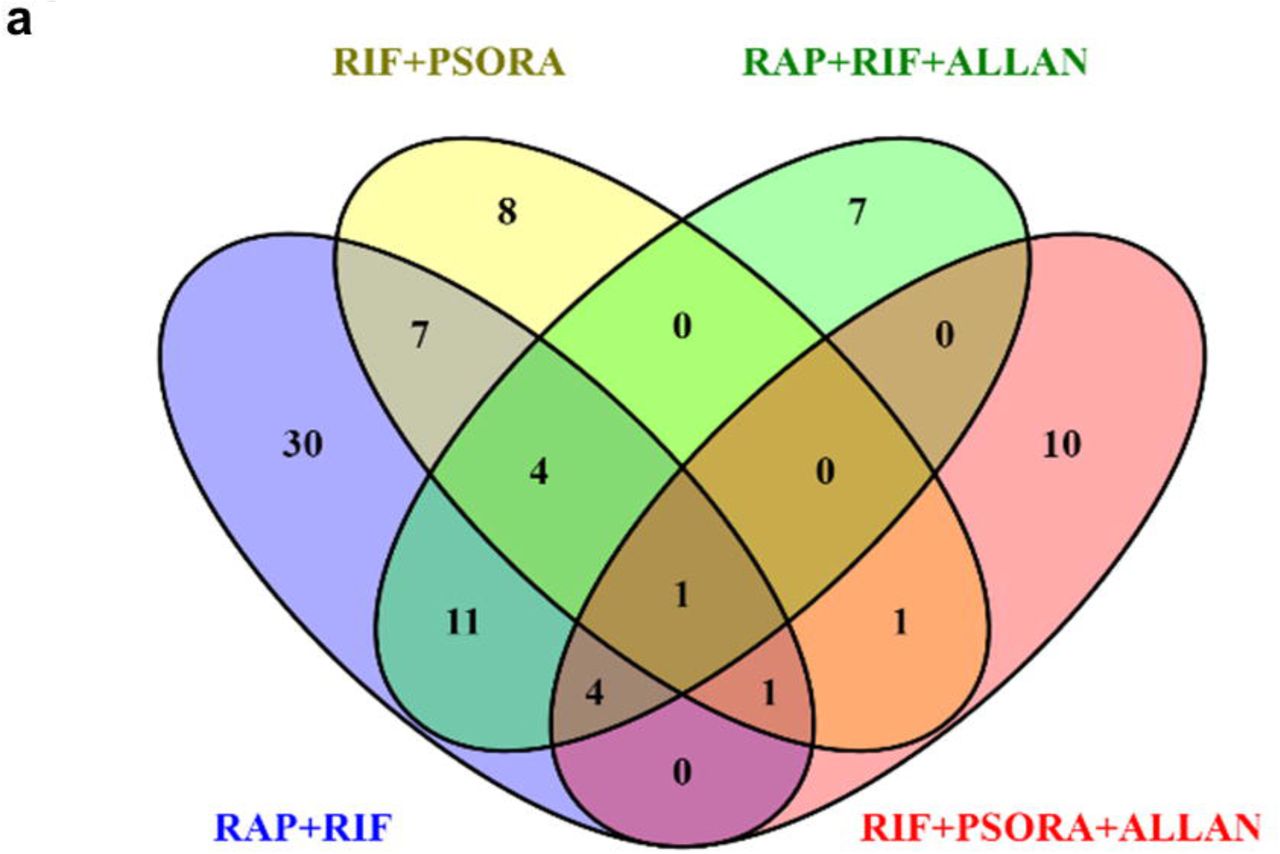



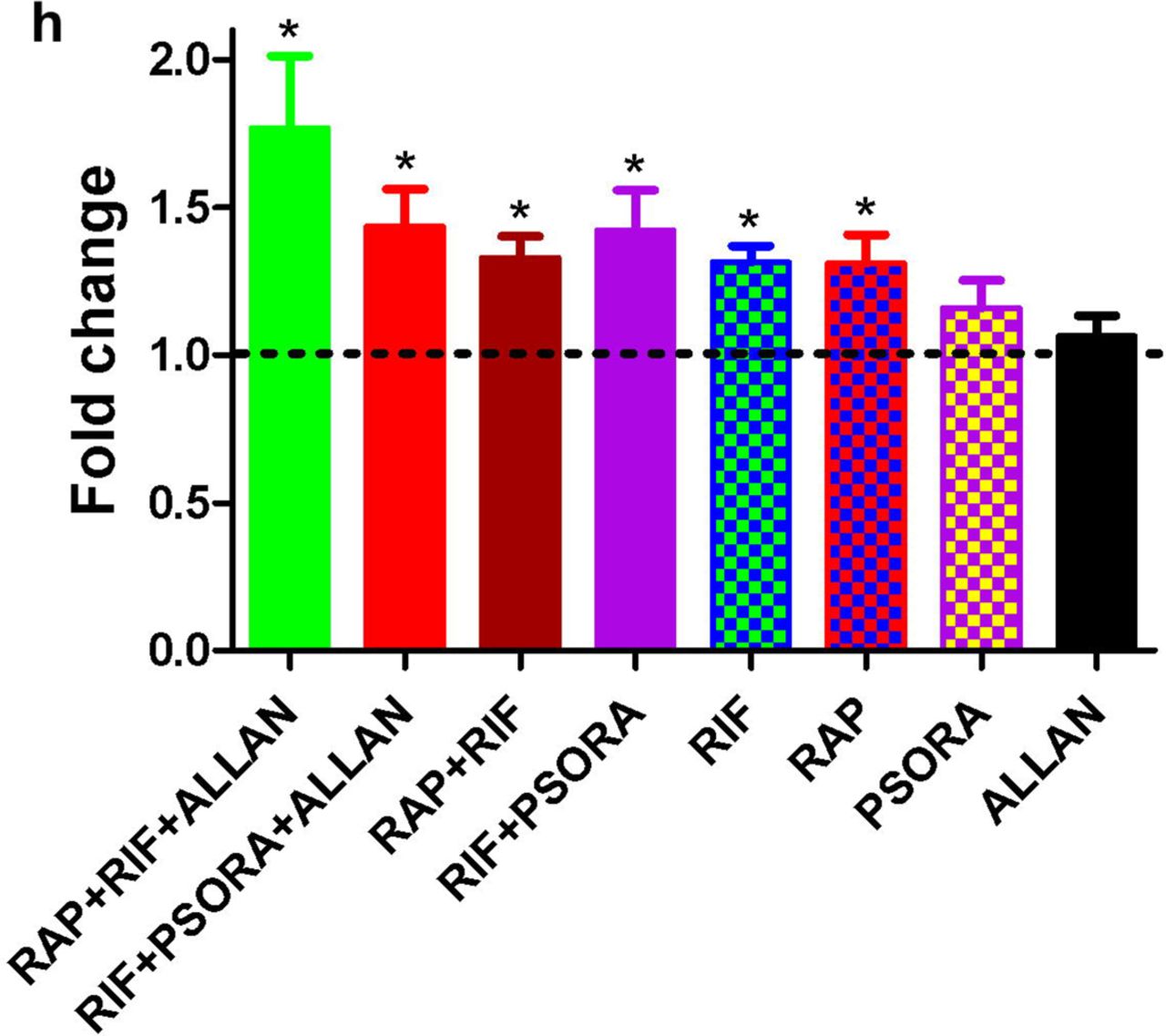
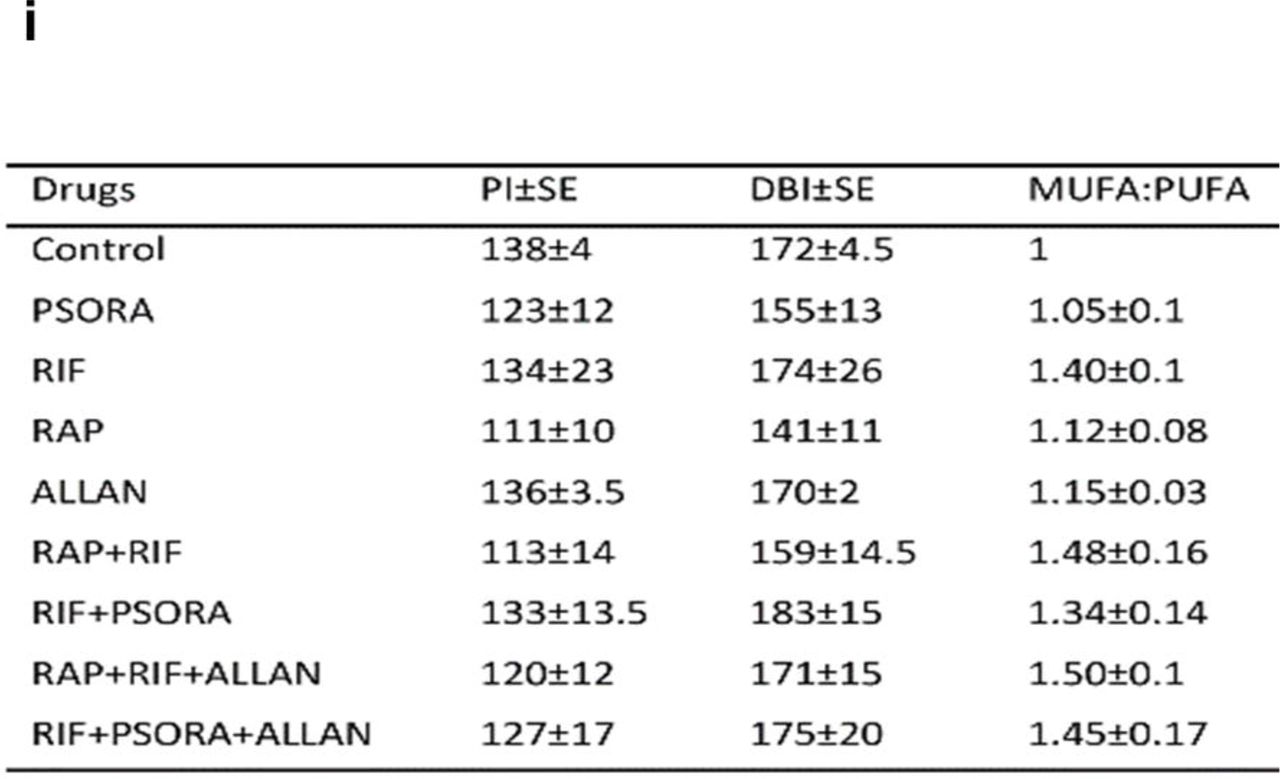
Fig. 4
Significance of TGFβ signaling pathway for drug synergy
The activation of the TGFβ signaling pathway identified in our study may be the main mechanism by which a synergistic effect is realized that extends the lifespan of model organisms. Previously, studies noted that the TGF mutation (daf-7) led to an increase in the lifespan through the insulin signaling pathway. Both mediators daf-2 and daf-7 also regulated the transcription of daf-16-dependent genes (Supplementary Scheme 7d). We wondered if it was possible, with the help of the selected combinations of drugs, to extend the life of daf-2 mutants, despite the fact that the life expectancy of animals due to this mutation was already higher. To begin with, we determined the lifetime of daf-2 mutated nematodes after each combination of drugs.
The increase in lifetime was recorded in RAP-containing combinations: RAP + RIF and RAP + RIF + ALLAN. However, the growth rate was almost the same as when using only the RAP drug. A synergistic effect lengthening the life of nematodes was not observed in any combination of drugs (Scheme 3c, additional Scheme 8, auxiliary table s2). The action of PSORA also contributed to an increase in the lifespan of daf-2 mutant worms, but the combination of drugs including this drug (RIF + PSORA and RIF + PSORA + ALLAN) had a neutral effect on the longevity of nematodes (Scheme 3c and additional scheme 8).
In the future, we tested the effectiveness of all synergistic combinations of drugs and drug substances of which they consisted on daf-7 mutants. In no case was a synergistic effect been detected. We concluded that drug synergy is due to the daf-7 signaling pathway, even though under these conditions, individual drugs from the combination are effective in terms of increasing life expectancy (Scheme 3d, additional Scheme 8).
Drug Synergy, MUFA, and Life Span
As previously reported in studies, metabolic rearrangements occur in long-lived age-1 and daf-2 mutant nematode lines, resulting in increased production and accumulation of fat. In addition, the TGFβ / daf-7 pathway regulates the metabolism of triacylglycerol (TAG) and it is known that mutant daf-7 nematodes store more fat. This information and the data of our work led us to study whether combinations of drugs characterized by synergism affect the lipid profile of nematodes with a TGFβ-blocked signaling pathway (Auxiliary table s3).
At the initial stage, we performed a transcriptome analysis of our results in order to find signaling pathways that change the lipid composition, and found that combinations of drugs with a synergistic effect increase the level of SREBP-1c: sbp-1 homolog in C. elegans.It serves as the main transcription factor that controls the genes responsible for the synthesis of various lipids and desaturase enzymes. The latter are involved in the formation of monounsaturated fatty acids (MUFA) (Scheme 4c, f). Subsequently, we performed a lipidome analysis using mass spectrometry to detect changes in the lipid profile after exposure to drugs. In nematodes, after the use of synergistic drug combinations, TAG stocks, the ratio of MUFA: PUFA (monounsaturated fatty acids to polyunsaturated fatty acids) and the amount of 16: 1 and 19: 1 monounsaturated fatty acids (MUFAs) increased significantly (Scheme 4f).
As a result, there was a decrease in the double bond index (DBI) (shows the degree of unsaturation of fatty acids) and the lipid peroxidation index (PI) (Scheme 4i). A low PI indicates that lipids contain fewer double bonds between the carbons, thereby reducing the ability of lipids to peroxidate. According to the results of various authors, a decrease in peroxidation ability was associated with an increase in life expectancy, possibly because lipids were less susceptible to oxidation in the body.
It is believed that by suppressing the peroxidation process, resistance to oxidative stress improves. In our work, in worms after application of synergistic combinations of drugs, indeed, such resistance increased (Scheme 5 e, f). Moreover, we noted an increase in the general level of sphingomyelin in nematodes (Scheme 4h). Scientists have shown that this indicator caused an increase in the lifespan of worms through increased autophagy.

Fig.5
Suppression of energy metabolism and blocking the work of the membrane chain of electron transport (ETC) can prolong the life of C. elegans. This fact does not explain the results in our study, since nematodes failed to detect a noticeable decrease in the rate of basal metabolism (Scheme 5i). The scientific literature describes that most often longevity was accompanied by factors such as: a slowdown in growth and development, as well as a decrease in fertility. We did not find that in worms that were given different synergistic combinations of drugs, the duration of the adult period of life and general fertility changed significantly. Although, after adding these combinations, a slight increase in the reproductive period in nematodes was recorded (Scheme 5a-c, additional Scheme 9a).
At the next stage, we determined: adaptation indicators, tolerance level of stressful situations and viability of nematodes. We evaluated the speed of spontaneous movement, resistance to heat shock, resistance to oxidative stress, and also calculated the viability of the worms on the scale of spontaneous mobility, calculated by the method of Herdon (Herndon). In the control group, the active life period was approximately 50% of the total nematode life span. A similar indicator in worms treated with RIF + PSORA + ALLAN or RAP + RIF + ALLAN preparations reached 57% and 63% of their extended life, respectively (Scheme 5d, additional data 9c). Thus, both the absolute lifetime and the relative period of active activity of nematodes increased significantly.
We observed that when the last worm died in the control group, in the other, more than half of the individuals showed an optimal level of vital activity (Scheme 5d, additional data 9c). An analysis of spontaneous movements showed that in the experimental group, regardless of the age of the worms, their mobility after the action of such drug combinations as: RIF + PSORA + ALLAN or RAP + RIF + ALLAN was noticeably higher than that of nematodes in the control group. Indeed, the spontaneous mobility of old individuals (18 days of life) in which medications were used did not differ from the motor activity of young worms (7 days of life) in the control group (Scheme 5g). In addition, drug therapy of worms increased their resistance to heat and oxidative stress (toxicological analysis, scheme 5e, f, additional scheme 9b).Our observations indicate that after the action of synergistic drug combinations, nematodes lengthened the period of active life, increased resistance to stress factors and, even, the mobility of individuals, while compensatory changes in their physiological development were absent or minimal.
Given these results, we doubt that the increase in life expectancy is due to a slowdown in the rate of biological aging. The rate of aging can be expressed as an indicator of the time during which the mortality of individuals doubles (MRDT or the time of doubling the intensity of mortality). Using the Survcurv analytical platform, we determined this parameter in model organisms after applying synergistic drug combinations. With the combined effect of RIF + PSORA + ALLAN preparations, the level of nematode MRDT was significantly higher than the same indicator in the control group (MRDT = 3.7 and 3 days, P <0.0001, respectively).
The mortality rate of young worms (IMR) in the experimental group was also significantly lower (IMR of the control group = 2.7e-3, IMR under the action of RIF + PSORA + ALLAN = 8.5e-4, RAP + RIF + ALLAN = 9.3e-4, P <0.001). We concluded that through the use of synergistic combinations of drugs, the aging process of nematodes slowed down and resistance to various negative factors in young individuals increased, which ultimately led to a prolongation of their life.
Preservation of the effect of drug synergism in Drosophila flies
One of the key issues in researching the aging process is the question of transferring the achieved result of prolonging life from one species to another. For this reason, we studied whether the effect of drug synergies that extend the life of C. elegans will persist in experiments on Drosophila melanogaster. Previously, in studies, scientists showed that RAP extended the life of fruit flies, while MET was not effective. We have consistently evaluated the effect of individual preparations and their combinations on the life time of male fruit flies. At the beginning, we demonstrated that the medicinal compounds RAP and ALLAN extended the average life of fruit flies, while RIF and PSORA increased only the maximum life expectancy of organisms (Scheme 6, supporting table s2).
A synergistic effect prolonging the life span of the flies was revealed in combinations of drugs based on the RAP compound: RAP + RIF and RAP + RIF + ALLAN (Scheme 6a). We did not find an increase in the average life time of the flies when using combinations of drugs containing PSORA: RIF + PSORA and RIF + PSORA + ALLAN (Scheme 6b). However, in comparison with the results of the action of individual drugs, the combination of RIF + PSORA drugs led to a synergistic effect that increases the maximum lifespan of organisms (Scheme 6c). Since the fruit fly Drosophila melanogaster retained the effect of drug synergy, we believe that the results of our work confirm the existence of an evolutionary-conservative mechanism, which determines the functioning of this synergistic effect.

Fig.6
Discussion
In this work, we were able to find several combinations of drugs with a synergistic effect. They selectively influenced certain signaling pathways associated with aging and longevity. In addition, signaling paths could intersect each other. Even though such drug combinations were used only in adulthood, C.elegans' active lifespan was doubled. The size of the effect of drug interventions was comparable to the effect after classical mutations that slow down aging. As far as we know, this study has become the largest in terms of the number and volume of drug interventions in adult animals.
When using synergistic medicinal combinations that increase the lifespan of worms, we were not able to detect any concomitant negative compensatory disorders or disorders in the development of the animal. Similar disorders have been observed in organisms with mutations in genes associated with aging. Also, the noted positive drug effect was not due to a decrease in the work of the membrane chain of electron transport (ETC) or inhibition of metabolism in worms. Evaluation of these indicators was carried out based on the level of oxygen consumption.
Indeed, animals that received medicinal combinations of drugs exceeded the control group of organisms in terms of motor activity. Physical form and activity were the same in older individuals in the experimental group and in younger ones in the control group (Scheme 5g). Mortality analysis showed that the synergistic effect of drug combinations slows the rate of biological aging by about 20% (Additional Scheme 10). To test the positive effect of drug synergism and its evolutionary conservatism, we performed several experiments on the fruit fly Drosophila melanogaster. Two of the four drug combinations confirmed the safety of a synergistic effect.
Evolutionarily, nematodes are closer to mammals than to flies. Therefore, such conservative mechanisms and signaling pathways in fruit flies and nematodes are ancient. Probably, initially the mechanism of synergistic action existed in the ancestor common to these three classes of animals.
In order to study the mechanism of action of drug synergy that prolongs the life of worms, we performed several epistasis experiments (Epistasis-suppression of the action of an allelic pair of genes by the non-allelic pair genome) and transcriptome analysis. As a result, we were able to find that the daf-2 / daf-16 (IGF / FOXO) and TGF (daf-7) signaling pathways play an important role in the functioning of the synergistic effect (Scheme 4j). The relationship between these two paths has also been confirmed in other studies. Their authors report that daf-7 regulated the lifespan of animals via the insulin signaling pathway, and the neural TGF pathway was associated with nutrient intake and longevity. In addition, daf-7 controlled the metabolism of C. elegans and the fat storage process. Mutations that extend the life of C. elegans,acted on the lipid metabolism of worms through an increase in the number of monounsaturated lipids and a decrease in the number of polyunsaturated lipids.
These results are consistent with the findings of our study. Drug synergy increased the level of the main transcription factor sbp-1, which affects lipid metabolism and the synthesis of monounsaturated lipids (Scheme 4c, f, additional scheme 5). Mass spectral analysis of the nematode lipidoma, which used various combinations of drugs with a synergistic effect, revealed changes in fat metabolism: activation of the sbp-1 factor, the accumulation of triacylglycerol and an increase in the ratio of mono- and polyunsaturated lipids in the direction of an increase in the former (including in two classes of lipids - phosphatidylcholine and phosphatidylethanolamine). Finally, in the scientific literature it is described that the predominance of monounsaturated lipids over polyunsaturated is found in the lipid profile of the erythrocyte membranes of children whose parents survived 90 or more years.
There is great interest among scientists in the world about the potential ability of MET and, possibly, the RAP compound, to slow down the development of age-related disorders and prevent human diseases. Given the increased attention to this issue, we want to mention experiments in which the effectiveness of the combination of MET and RAP preparations in C. elegans and mice was weak. Such results have disappointed many scientists.
In our work, we demonstrated that life expectancy was determined by a complex of signaling pathways and interacting genes and biochemical molecules. The simultaneous influence of certain signaling pathways on several targets can lead to a noticeable positive effect and sometimes unpredictable results. In this study, based on the principle of evidence, we used drugs that act on key signaling pathways.
Suddenly, we discovered a synergistic effect, which was universal and evolutionarily conservative in nature. The results of our work confirm the validity of using drugs to slow the rate of biological aging, which pointly change the activity of many conservative signaling pathways at once. If scientists manage to transfer this principle of action to people, then this will significantly increase the effectiveness of medical care and the economic well-being of society.
Translation: Tatyana Gneteeva.